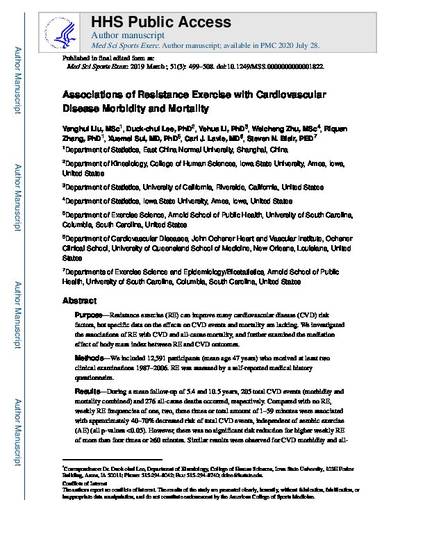
Purpose: Resistance exercise (RE) can improve many cardiovascular disease (CVD) risk factors, but specific data on the effects on CVD events and mortality are lacking. We investigated the associations of RE with CVD and all-cause mortality and further examined the mediation effect of body mass index (BMI) between RE and CVD outcomes.
Methods: We included 12,591 participants (mean age, 47 yr) who received at least two clinical examinations 1987-2006. RE was assessed by a self-reported medical history questionnaire.
Results: During a mean follow-up of 5.4 and 10.5 yr, 205 total CVD events (morbidity and mortality combined) and 276 all-cause deaths occurred, respectively. Compared with no RE, weekly RE frequencies of one, two, three times or total amount of 1-59 min were associated with approximately 40%-70% decreased risk of total CVD events, independent of aerobic exercise (AE) (all P values <0.05). However, there was no significant risk reduction for higher weekly RE of more than four times or ≥60 min. Similar results were observed for CVD morbidity and all-cause mortality. In the stratified analyses by AE, weekly RE of one time or 1-59 min was associated with lower risks of total CVD events and CVD morbidity regardless of meeting the AE guidelines. Our mediation analysis showed that RE was associated with the risk of total CVD events in two ways: RE had a direct U-shaped association with CVD risk (P value for quadratic trend <0.001) and RE indirectly lowered CVD risk by decreasing BMI.
Conclusion: Even one time or less than 1 h·wk of RE, independent of AE, is associated with reduced risks of CVD and all-cause mortality. BMI mediates the association of RE with total CVD events.
Available at: http://works.bepress.com/duck-chul_lee/55/

This accepted article is published as Liu Y, Lee DC (corresponding author), Li Y, Zhu W, Zhang R, Sui X, Lavie CJ, Blair SN. Associations of Resistance Exercise with Cardiovascular Disease Morbidity and Mortality. Med Sci Sports Exerc. 2019;51(3):499-508. doi:10.1249/MSS.0000000000001822. Posted with permission.